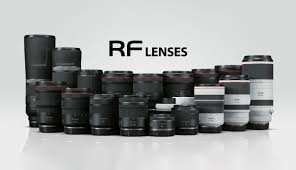
canon rf lens
Why Canon RF Lenses Are Changing the Game
The world of photography has been rapidly evolving, and at the center of this transformation is the Canon RF lens system. Introduced alongside Canon’s full-frame mirrorless cameras, the RF lens mount is more than just a physical change—it’s a technical leap forward. With wider mounts, shorter flange distances, and optimized optical formulas, RF lenses deliver stunning image quality, fast autofocus, and compact designs. Whether you’re a professional, hobbyist, or hybrid shooter, Canon RF lenses provide the versatility and performance required for today’s creative demands. From ultra-wide primes to telephoto zooms, Canon’s RF lineup redefines what’s possible in photography and videography.
What Is a Canon RF Lens?
A Canon RF lens is a lens designed specifically for Canon’s mirrorless full-frame cameras that use the RF mount, including the EOS R series like EOS R5, R6, R8, and R10. Unlike EF or EF-S lenses, RF lenses are engineered to work seamlessly with the mirrorless design, offering faster data transfer, better autofocus, and more precise communication between lens and camera. These lenses leverage advanced optics, built-in control rings, and in-lens image stabilization to give users more control and sharper results across the board. The RF mount, introduced in 2018, is larger in diameter and closer to the sensor, which improves light transmission and lens design possibilities—especially for high-performance lenses.
Top Features of Canon RF Lenses
Canon RF lenses are not just modified versions of EF lenses—they’re purpose-built with next-generation features to meet modern creative standards:
- Wider Lens Mount (54mm): Allows more light and faster communication between camera and lens
- Shorter Flange Distance (20mm): Enables compact designs and improved optical performance
- Customizable Control Ring: Provides instant access to ISO, aperture, shutter speed, or exposure compensation
- In-Lens Image Stabilization (IS): Many RF lenses come with optical stabilization, and when paired with EOS R bodies with IBIS, users can achieve up to 8 stops of correction
- Fast and Quiet Autofocus: Advanced focusing motors ensure smooth performance for both photos and video
- Weather-Sealed Construction: Higher-end lenses offer dust- and moisture-resistance for professionals working in tough environments
These features make Canon RF lenses ideal for photographers, videographers, vloggers, and content creators.
Best Canon RF Lenses You Should Know
Whether you’re looking to build your first RF kit or expand your collection, here are some of the best Canon RF lenses available today:
1. Canon RF 24-70mm f/2.8L IS USM
This professional zoom lens offers exceptional sharpness, fast aperture, and stabilization, making it a favorite for weddings, portraits, and events. It features Nano USM for fast, silent focusing and delivers premium results in both photo and video modes.
🔗 Canon RF 24-70mm f/2.8L – Official Site
2. Canon RF 50mm f/1.8 STM
An affordable prime lens that delivers excellent low-light performance and bokeh. It’s lightweight, compact, and perfect for everyday photography or portraits on a budget.
🔗 Canon RF 50mm f/1.8 – View on B&H
3. Canon RF 70-200mm f/2.8L IS USM
This telephoto zoom is surprisingly compact for its range and aperture. It’s ideal for sports, wildlife, portraits, and events. The fast f/2.8 aperture and built-in 5-stop image stabilization ensure excellent results in any lighting condition.
🔗 Canon RF 70-200mm f/2.8L – See Specs
4. Canon RF 15-35mm f/2.8L IS USM
One of the best ultra-wide zoom lenses for full-frame mirrorless systems. Ideal for architecture, landscapes, and interiors. It features excellent sharpness across the frame and built-in stabilization.
🔗 Canon RF 15-35mm f/2.8L – Learn More
5. Canon RF 85mm f/1.2L USM
An ultimate portrait lens, known for its razor-sharp focus and buttery-smooth bokeh. It’s heavy and premium-priced but delivers extraordinary results for pros.
🔗 Canon RF 85mm f/1.2L – Explore on Adorama
Each of these lenses serves a specific purpose, and Canon continues to expand the RF lineup to cover every focal length and use case.
Canon RF Lenses vs EF Lenses: What’s the Difference?
The shift from EF to RF isn’t just about a new mount—it’s about enhancing performance, size, and image quality. Here are some key differences:
- Image Quality: RF lenses are sharper edge-to-edge and exhibit less distortion and chromatic aberration
- Size and Weight: Many RF lenses are more compact due to the shorter flange distance
- Autofocus Performance: RF lenses offer quicker and more silent AF motors, ideal for video
- Control Ring: Built-in customizable ring gives you faster manual settings adjustments
- Lens Communication: RF lenses allow faster, high-bandwidth data transfer, improving stabilization and autofocus precision
While EF lenses can still be used with the Canon EF to RF adapter, investing in native Canon RF lenses ensures maximum performance and future-proofing.
Who Should Buy a Canon RF Lens?
If you own a Canon EOS R-series camera, the RF lenses are designed to extract the most out of your gear. Here’s who should consider them:
- Professional Photographers: Wedding, portrait, fashion, and sports shooters will benefit from RF’s sharpness, fast apertures, and reliability
- Videographers: Silent autofocus, image stabilization, and focus-by-wire systems make RF lenses ideal for professional video production
- Content Creators & YouTubers: Compact lenses with great low-light performance and autofocus tracking allow seamless content creation
- Enthusiasts and Hobbyists: Even budget-friendly RF options like the 50mm f/1.8 give impressive quality for beginners and casual users
- Hybrid Shooters: If you switch between photos and videos, the RF system balances both worlds beautifully
Anyone invested in Canon’s mirrorless ecosystem will find RF lenses to be the logical next step in their creative journey.
Tips for Buying Canon RF Lenses
Before making a purchase, consider the following tips to make sure you get the best value:
- Determine your style: Portrait? Landscape? Video? Choose a lens that fits your most-used focal lengths
- Check for IS (Image Stabilization): Especially if your camera body lacks in-body stabilization
- Compare aperture vs zoom: Fast primes offer better low-light but zooms offer more flexibility
- Look for weather-sealing if you often shoot outdoors
- Don’t ignore budget options: Canon has released excellent affordable RF lenses that punch above their price
As Canon expands its RF lineup, new options keep coming that meet both amateur and professional needs.
Maintaining and Using Canon RF Lenses
To keep your Canon RF lens in top condition:
- Use a UV filter to protect the front glass
- Store lenses in a dry, padded case to prevent dust and moisture buildup
- Clean with microfiber cloth and blower—never use rough materials
- Avoid direct sun exposure to prevent internal fogging or overheating
- Keep firmware updated through your Canon camera’s interface
Proper care ensures your investment remains sharp, fast, and reliable for years to come.
Conclusion: Canon RF Lenses Are the Future of Imaging
The Canon RF lens system represents a bold leap forward in camera lens technology. Designed specifically for mirrorless performance, RF lenses deliver unmatched sharpness, speed, and versatility across photography and video applications. Whether you’re just entering the world of full-frame mirrorless or upgrading from DSLR gear, these lenses offer an experience that’s not just compatible—but optimized for modern creativity. With options for every budget, shooting style, and skill level, Canon’s RF lineup is not just the present—it’s the future. So, if you’re ready to get the most out of your EOS R camera, it’s time to invest in a Canon RF lens and unlock your true creative potential.






